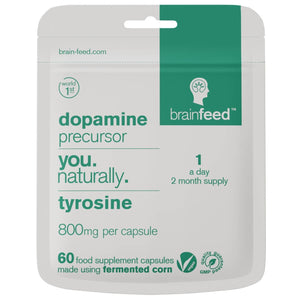Endorphins vs dopamine: The best ways to boost your happy chemicals.
filter
Your brain communicates through messages being transferred between brain cells. It achieves this using brain chemicals, also known as neurotransmitters. There are well over 100 brain chemicals that perform a variety of functions [1 Trusted Source 2001 - Neurotransmitters 3rd-party source Neuroscience, 2nd edition ] . A group of brain chemicals are involved in making you feel joy. These chemicals elicit positive emotions in different ways. Two of these are endorphins and dopamine. Read to find out how these differ and the best ways to boost your positive chemicals.
What does dopamine do?
Have you had to undertake a herculean project that required dedication and effort with the sweet taste of success upon completion? You powered through the project and accomplished a congratulatory prize witnessed by all. The brain chemical that got you through this is your reward and pleasure brain chemical, dopamine. It also plays a central role in motivation.
Your brain releases it when it is expecting a reward and also when you attain the reward [1 Trusted Source 2012 - The Journal of Neuroscience Human study Dopaminergic Mechanisms of Individual Differences in Human Effort-Based Decision-Making ] . This adds to the loop of motivating you to continue pursuing that rewarding feeling. Great food, sex, exercise, and adventures all contribute to boosting dopamine. Your brain loves new experiences due to the anticipated reward. The joy you feel after exploring a new city is brought to you by dopamine.
To produce sufficient dopamine, you must ensure an adequate intake of its building block, tyrosine. Tyrosine is found in protein rich foods. It is also available in supplemental form to boost intake. brain feed has produced the world’s 1st natural 800mg tyrosine capsule made from fermented corn for an efficient way to increase dopamine production.
What do endorphins do?
Endorphins are brain chemicals also designed to make you feel great. Are endorphins neurotransmitters? Yes, though they are chemically different to dopamine and work differently. Another difference is that dietary building blocks of endorphins are yet to be discovered. Intake of tyrosine can contribute to dopamine production, but increasing endorphin production through intake of nutrients is currently impossible.
Endorphins are internally produced pain relievers (Endorphin comes from endogenous morphine) [3 Trusted Source 2023 - StatPearls Publishing 3rd-party source Biochemistry, Endorphin ] . Broadly, they are of 3 types- with beta-endorphin being the most prevalent form [3 Trusted Source 2023 - StatPearls Publishing 3rd-party source Biochemistry, Endorphin ] . Endorphins block pain to provide relief and they are also released in some circumstances. So, what releases endorphins? They are released in pleasurable activities like exercise, sex, and indulging in good food and laughter. The euphoria you feel after a good run is courtesy of endorphin release (runner’s high) [4 Trusted Source 2008 - Cerebral Cortex Human study The Runner's High: Opioidergic Mechanisms in the Human Brain ] . Endorphins have been researched for the pleasure you feel after exercise. If you are looking to boost your endorphin release, ramp up the intensity. A brain scan study found that an hour of high intensity exercises released more endorphins than a moderate intensity exercise session [5 Trusted Source 2017 - Neuropsychopharmacology Human study Opioid Release after High-Intensity Interval Training in Healthy Human Subjects ] .
How to increase your dopamine and endorphin levels?
Here are 3 ways to maximise both dopamine and endorphin for an all-rounded positive feel:
-
Get more exercise
Exercise benefits mental health in numerous ways, including boosting both dopamine and endorphins levels. Exercise produces nutrients that support chemical reactions involved in production of dopamine [6 Trusted Source 2013 - Brain Sciences Research evaluation Exercise Benefits Brain Function: The Monoamine Connection ] . Animal studies found that exercise can boost dopamine levels by 40% and the levels stayed high for a week [8 Trusted Source 2022 - The Journal of Neuroscience Animal study Voluntary Exercise Boosts Striatal Dopamine Release: Evidence for the Necessary and Sufficient Role of BDNF ] . Dopamine is also involved in motivating you to exercise, to experience the rewarding feeling of completing a great workout [7 Trusted Source 2021 - Brain Sciences Systematic and meta-analysis Bidirectional Association between Physical Activity and Dopamine Across Adulthood—A Systematic Review ] . Physical activity also releases endorphins. Even 15-30 mins of exercise can give you an endorphin surge [9 Trusted Source 1990 - Medicine and Science in Sports and Exercise Human study Plasma beta-endorphin concentration: response to intensity and duration of exercise ] , though it is recommended to aim for high intensity exercises. -
Engage in upbeat music
Music and its associated activities like singing and dancing are synonymous with joy and fun. The happy feelings associated with listening to music is related to its association with the dopamine system. Brain scans have found that listening to pleasurable music improves blood flow to brain areas that produce dopamine [10 Trusted Source 2021 - Brain, behavior, & immunity - health Systematic and meta-analysis Music, mental health, and immunity ] . In terms of endorphin levels, a study found that physical exertion involved in singing, dancing, and playing musical instruments lead to endorphin release due to increased pain threshold [11 Trusted Source 2012 - Evolutionary Psychology Human study Performance of Music Elevates Pain Threshold and Positive Affect: Implications for the Evolutionary Function of Music ] . One way to boost your dopamine and endorphin is to indulge in singing a lively sing-along in your leisure time. -
Eat your way to happy chemicals
The edible way to increase dopamine production is to increase intake of tyrosine rich foods like tofu, beef, and cheese. If these foods are low in your diet or you are simply looking for a convenient and efficient way, try brain feed’s 800mg tyrosine. Since dietary building blocks of endorphins are yet to be discovered, there are certain foods that can help with the release of endorphins due to their desirable nature. Chocolate is often considered to be a pleasurable food. One reason might be its ability to release endorphins [12 Trusted Source 2013 - British Journal of Clinical Pharmacology Research evaluation The neuroprotective effects of cocoa flavanol and its influence on cognitive performance ] . Sweet and palatable foods are intrinsically desired, and chocolate fits the bill perfectly, by involving the reward system of dopamine as well [12 Trusted Source 2013 - British Journal of Clinical Pharmacology Research evaluation The neuroprotective effects of cocoa flavanol and its influence on cognitive performance ] . For a healthier twist, opt for dark chocolate. It contains a chemical that releases endorphins, thus making you feel joy [13 Trusted Source 2022 - Current Research in Food Science Research evaluation Dark chocolate: An overview of its biological activity, processing, and fortification approaches ] .
Dopamine and endorphins form a part of your positive chemicals that can help improve mood and contribute to mental wellbeing.
References
- Purves D, Augustine GJ, Fitzpatrick D, et al., editors. Neuroscience. 2nd edition. Sunderland (MA): Sinauer Associates; 2001. Chapter 6, Neurotransmitters. https://www.ncbi.nlm.nih.gov/books/NBK10799/
- Treadway, M.T. et al. (2012). Dopaminergic Mechanisms of Individual Differences in Human Effort-Based Decision-Making. The Journal of Neuroscience, [online] 32(18), pp.6170–6176. https://www.jneurosci.org/content/32/18/6170
- Chaudhry SR, Gossman W. Biochemistry, Endorphin. [Updated 2023 Apr 3]. In: StatPearls [Internet]. Treasure Island (FL): StatPearls Publishing; 2023 Jan-. https://www.ncbi.nlm.nih.gov/books/NBK470306/
- Boecker, H. et al. (2008). The runner’s high: opioidergic mechanisms in the human brain. Cerebral cortex (New York, N.Y. : 1991), [online] 18(11), pp.2523–31. https://academic.oup.com/cercor/article-abstract/18/11/2523/291108?redirectedFrom=fulltext
- Saanijoki, T. et al. (2017). Opioid Release after High-Intensity Interval Training in Healthy Human Subjects. Neuropsychopharmacology, 43(2), pp.246–254. https://www.nature.com/articles/npp2017148
- Lin, T. W., & Kuo, Y. M. (2013). Exercise benefits brain function: the monoamine connection. Brain sciences, 3(1), 39–53. https://www.mdpi.com/2076-3425/3/1/39
- Marques, A. et al. (2021). Bidirectional Association between Physical Activity and Dopamine Across Adulthood-A Systematic Review. Brain sciences, 11(7), 829. https://www.mdpi.com/2076-3425/11/7/829
- Bastioli, G. et al. (2022). Voluntary Exercise Boosts Striatal Dopamine Release: Evidence for the Necessary and Sufficient Role of BDNF. Journal of Neuroscience, [online] 42(23), pp.4725–4736. https://www.jneurosci.org/content/42/23/4725
- Goldfarb, A. H. et al. (1990). Plasma beta-endorphin concentration: response to intensity and duration of exercise. Medicine and science in sports and exercise. https://www.researchgate.net/publication/21015414_Plasma_beta-endorphin_concentration_Response_to_intensity_and_duration_of_exercise
- Rebecchini L. (2021). Music, mental health, and immunity. Brain, behavior, & immunity - health, 18, 100374. https://www.sciencedirect.com/science/article/pii/S2666354621001770?via%3Dihub
- Dunbar, R.I.M., Kaskatis, K., MacDonald, I. and Barra, V. (2012). Performance of Music Elevates Pain Threshold and Positive Affect: Implications for the Evolutionary Function of Music. Evolutionary Psychology, 10(4), p.147470491201000. https://journals.sagepub.com/doi/10.1177/147470491201000403
- Nehlig A. (2013). The neuroprotective effects of cocoa flavanol and its influence on cognitive performance. British journal of clinical pharmacology, 75(3), 716–727. https://bpspubs.onlinelibrary.wiley.com/doi/10.1111/j.1365-2125.2012.04378.x
- Samanta, S. et al. (2022). Dark chocolate: An overview of its biological activity, processing, and fortification approaches. Current research in food science, 5, 1916–1943. https://www.sciencedirect.com/science/article/pii/S2665927122001873?via%3Dihub


 alertness
alertness
 cognition
cognition
 sleep
sleep
 wellbeing
wellbeing







Leave a comment
Open tab